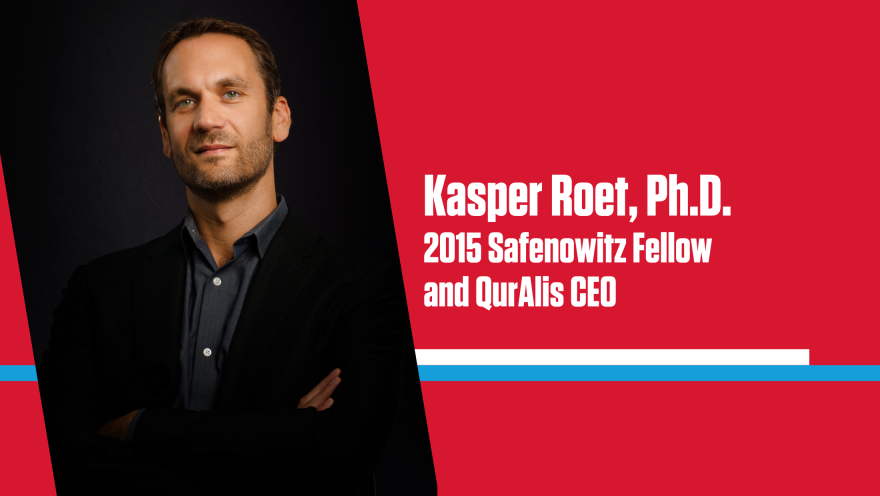In honor of the 20th year of our Milton Safenowitz Postdoctoral Fellowship Program, we are catching up with some of our funded fellows, like Kasper Roet, Ph.D., CEO and co-founder of QurAlis, to find out how the award impacted his research and career.
Dr. Roet became a neuroscientist with a clear vision for what he wanted to achieve.
“I’m not traditionally the academic scientist that spends their whole life trying to figure something out. I’m really focused on: How can we help people?” He explained, “The goal was always to develop therapies. The goal was always to start a company.”

Early on, this path led Dr. Roet, who earned his Ph.D. from the Netherlands Institute for Neuroscience and the Free University of Amsterdam, away from ALS and toward spinal cord injury—a “pretty clear-cut problem” with well-defined pathways that could be targeted with treatments.
He shared that, at the time, he felt not enough was known about ALS to be able to treat it effectively. Following the Ice Bucket Challenge, a lot changed as researchers began to dive deeper into the genetics of ALS.
“Because of the Ice Bucket Challenge and all of the money it dedicated to ALS research, there was really an expansion of our understanding of the disease,” Dr. Roet recalled. “I started to get really interested because I was encouraged that now we can start to see pathways emerge. We may be able to really understand this disease and actually do something for patients.”
New gene discoveries, coupled with the incredible advancements being made in stem cell modeling, compelled Dr. Roet to move to Boston where he could collaborate with two prominent ALS researchers: Clifford Woolf, M.D., Ph.D., and Kevin Eggan, Ph.D.
“The work by Clifford and Kevin was truly revolutionary—we have genetics, we have disease genes, and now we have patients’ own cells to test hypotheses and to test potential therapeutics. With these foundations, we should be able to develop therapies that are really going to impact patients’ lives in a very positive way,” he said. “And so that brought me to Boston, that brought me to Harvard and Kevin and Clifford, to learn the stem cell technology because I thought that was going to be the future of medicine development for ALS.”
The group had previously discovered that a potassium channel called Kv7.2/7.3 was dysfunctional in ALS, making the cells hyperexcitable. This means that the motor neurons of people living with ALS generate electrical signals more readily than normal, leaving them vulnerable to degeneration and cell death.
When Dr. Roet joined Dr. Woolf’s lab as a postdoctoral researcher, he focused on uncovering more about the role of potassium channels in ALS and determining whether one (or more) of these channels could be a good potential target for developing new drugs. With the support of a Milton Safenowitz Postdoctoral Fellowship, Dr. Roet did an “unbiased screen” to look at all the different “druggable” potassium channels.
“The award gave me the means to do this very thoroughly. And at the end of it, it really validated the Kv7.2/7.3 channel as the most prominent target for ALS,” he said.
Dr. Roet went on to co-found QurAlis with Drs. Woolf and Eggan in December 2016. The company is continuing to pursue the Kv7.2/7.3 channel as a therapeutic target and has completed Phase 1 clinical testing in healthy volunteers of a Kv7 opener called QRL-101 that aims to reduce the neurodegeneration triggered by hyperexcitability.
“That was really the goal of my academic work, to figure out: What are the most promising targets? Which precision therapy programs should we pursue? And once that became clear, we started QurAlis,” Dr. Roet said. “The Safenowitz Fellowship helped us to home in on that, to really tell us what is the most promising therapeutic strategy.”
Since then, Dr. Roet and QurAlis have continued to focus on ALS genetics, expanding their drug pipeline to include two other promising targets linked to both familial and sporadic forms of ALS: STATHMIN-2 and UNC13A. QurAlis recently licensed its UNC13A program to Eli Lilly and Company.
“I believe, personally, that genetic medicine is going to be the way to be successful in developing meaningful therapies for ALS. And we now have a broad genetic understanding of disease,” Dr. Roet said. “And so, I believe we are going to be successful, not QurAlis alone, but as a community, and that we should be able to stop ALS.”
To learn more about the genetics of ALS, click HERE.
If you would like to receive monthly ALS research updates, SUBSCRIBE to our newsletter, Research Matters.
To continue to follow stories about people living with ALS in the community and learn more about the disease, follow our blog HERE.


Join the conversation. Please comment below.